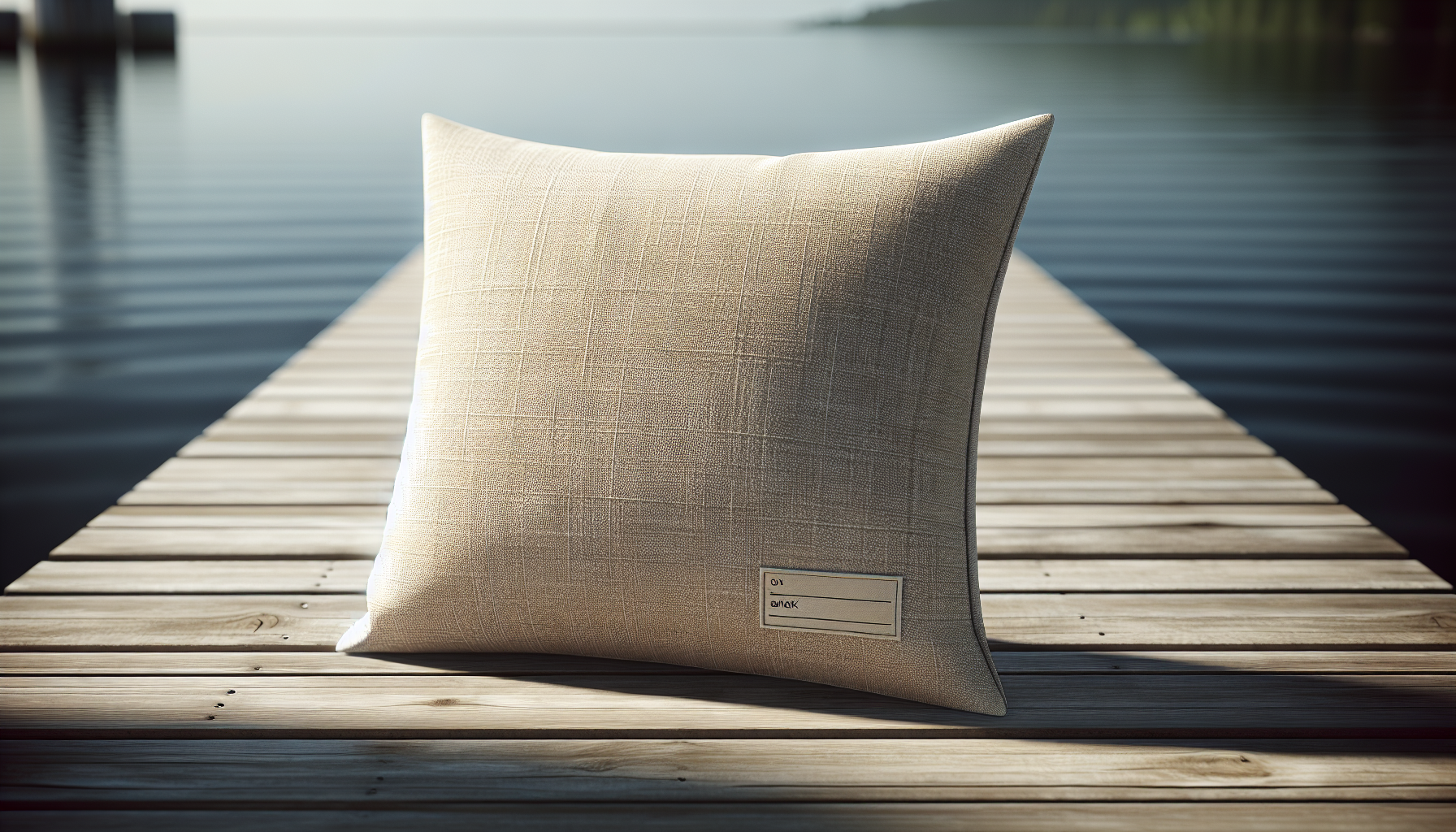When To File ISF For Outdoor Pillows And Cushions
?Do you know exactly when you must submit an Importer Security Filing (ISF) for a sea shipment of outdoor pillows and cushions to the United States?

When To File ISF For Outdoor Pillows And Cushions
This article clarifies the timing, required data elements, compliance risks, and practical steps you must take when importing outdoor pillows and cushions by ocean freight. It also presents a start-to-finish user journey and edge cases to guide accurate ISF submission.
Basic definition: what is ISF and why it matters to you
The Importer Security Filing (commonly “ISF” or “10+2”) is a U.S. Customs and Border Protection (CBP) requirement for ocean cargo bound to the United States. You must submit specific information to CBP before the vessel departs the foreign port to allow risk assessment and manifesting. For consumer goods such as outdoor pillows and cushions, the ISF helps determine the security and admissibility of cargo.
Timing requirement: the critical deadline you must observe
You must submit the ISF no later than 24 hours before the vessel departs the foreign port of loading. This deadline is fixed for ocean shipments to U.S. ports regardless of commodity. Filing earlier than 24 hours is permitted and is often advisable to accommodate data verification and potential amendments.
Who is responsible for filing
You, as the importer of record or your designated agent (such as a licensed customs broker or third-party filer), are responsible for ensuring ISF submission. If you retain an outside service, confirm they are authorized and reliable; for example, some importers work with an ISF Filing Expert in California, United States to handle regional logistics and regulatory nuances.
ISF data elements: what information you must provide
You must provide the standard ISF importer-side elements. Present this list to your filer and ensure accuracy:
- Importer of record name and address
- Consignee name and address (or “To order” parties if applicable)
- Seller (owner) name and address
- Buyer (owner) name and address
- Ship-to party name and address
- Manufacturer (or supplier) name and address
- Country of origin of the goods
- Harmonized Tariff Schedule (HTS) number or commodity description
- Container stuffing location (if different from country of origin)
- Consolidator (stuffer) name and address (when applicable)
Also note that carriers provide two additional elements (the “+2”), but you must coordinate to ensure those are accurate in the bill of lading.
Product specifics that affect filing
Outdoor pillows and cushions frequently use textiles, foams, and chemical treatments. While ISF does not require product testing results, you must accurately identify the commodity description and country of origin. Misclassification or incomplete manufacturing information can lead to ISF holds or checks that delay release.
Step-by-step user journey: from placing the order to release at U.S. port
- Place purchase order with overseas supplier and obtain accurate manufacturer and stuffing details.
- Confirm container stuffing location and anticipated vessel sailing schedule.
- Collect commercial invoice, packing list, bill of lading, and supplier certificates (origin, treatment declarations).
- Instruct your customs broker or ISF filer to submit the ISF at least 24 hours before vessel departure.
- Monitor carrier manifest and CBP notifications; respond to requests for additional information promptly.
- Upon vessel arrival and entry processing, secure the Customs entry, bond, and any required permits for release.
- Arrange inland transport and final delivery to your warehouse or distribution center.
Edge cases and common complications
- Transshipment: If cargo transships through a third-country port, you must ensure ISF covers the actual foreign port of loading for the original vessel leg. Clarify routing with the carrier and include transshipment points if required by your filer.
- FROB (Freight Remaining on Board) or in-bond movements: If goods are remaining on board for onward movement, coordinate ISF and in-bond paperwork carefully to avoid duplicate filings or gaps.
- Consolidated shipments: If your pillows are part of a consolidation, ensure the consolidator (stuffer) information is included and accurate. Consolidated shipments may require additional coordination among multiple buyers/consignees.
- Late booking or last-minute substitutions: Files submitted after the 24-hour window expose you to penalties and potential container holds. If a late amendment is necessary, submit corrected ISF data as soon as possible and document the reason.
Compliance risks and penalties you must avoid
Noncompliance can trigger civil penalties, increased inspections, or cargo holds. CBP historically has assessed monetary penalties for failure to file, filing inaccurate data, or submitting late. Additionally, inaccurate ISF data might cause your shipment to be subject to examination or manifest hold, slowing distribution and increasing storage or demurrage costs.
Practical tips to maintain compliance
- Validate manufacturer and stuffing locations at order confirmation.
- Use consistent HTS descriptions and cross-check with your customs broker.
- Maintain a documented audit trail of communications and data corrections.
- Invest in early ISF submission — submit when you receive confirmed vessel and stuffing details.
- Train procurement and logistics teams on the 24-hour rule and required data elements.
Recordkeeping and audit readiness
Keep ISF records and supporting documents (invoices, packing lists, communications) for at least five years, as CBP may review filings during audits. A well-documented trail supports any reasonable cause explanations for amendments or late submissions.
Conclusion: when specifically to file for outdoor pillows and cushions
File the ISF at least 24 hours prior to the vessel’s departure from the foreign port. Given the typical supply chain for textile-based household goods, you should aim to submit earlier when stuffing locations, manufacturer identities, or consolidation arrangements are likely to change. Accurate and timely ISF submission reduces the risk of customs delays, penalties, and unexpected costs.
Final compliance checklist
- Confirm manufacturer and stuffing location
- Obtain accurate seller/buyer/consignee information
- Determine and confirm HTS/commodity description
- Provide consolidator information if applicable
- Submit ISF ≥ 24 hours before vessel departure
- Keep comprehensive records for auditability
By observing these steps and coordinating with your customs broker, you will reduce risk and improve predictability in the import process for outdoor pillows and cushions.
?Are you clear on the filing timeline and documentation requirements for ISF, or do you need specific guidance for an upcoming shipment?
?Have you considered engaging a specialized advisor to reduce ISF errors and improve predictability in your ocean imports of outdoor pillows and cushions?
When To File ISF For Outdoor Pillows And Cushions
This version emphasizes consultant-based approaches and clarifies the procedural and regulatory responsibilities that you must satisfy during the import process. It offers an end-to-end perspective and compliance guidance.
What the ISF requirement entails for your shipments
ISF requires a set of pre-arrival data submissions that enable CBP to perform risk assessments. For your outdoor pillows and cushions imported by ocean freight, accurate submission of the ISF will prevent manifest holds and reduce the likelihood of physical inspections that delay distribution.
When exactly to file: the 24-hour rule explained
You must file the ISF at least 24 hours prior to the vessel sailing from the foreign port. Filing earlier is prudent, especially when multiple parties (manufacturer, consolidator, carrier) are involved. If you require professional assistance, an ISF Filing Expert Consultant can help assemble and validate the required elements and communicate with carriers and brokers.
Core ISF elements and data integrity
Provide the required importer-side elements (importer, consignee, seller, buyer, ship-to, manufacturer, country of origin, commodity HTS, stuffing location, consolidator). Accuracy is crucial; inconsistent or incomplete data is a leading cause of holds and CBP inquiries.
Start-to-finish process: the user journey
- Order and supplier confirmation: confirm manufacturer and stuffing point.
- Obtain documents: invoice, packing list, purchase order, vendor declarations.
- Coordinate with consolidator and carrier for stowage and booking details.
- Submit ISF ≥ 24 hours before vessel departure.
- Monitor carrier manifest and CBP messages; respond to queries.
- Prepare customs entry and ensure bond coverage before cargo release.
- Arrange last-mile delivery and retain documentation.
Edge cases you must plan for
- Vessel diversions or schedule changes: if sailing dates shift, you may need to amend ISF data.
- Change of manufacturer or supplier shortly before stuffing: submit amendments promptly and document reasons.
- High-value or regulated fillings (treated textiles): coordinate with CBP and other agencies if chemical treatments trigger other regulatory requirements.
Compliance best practices and mitigation strategies
- Standardize data collection templates across procurement and logistics teams.
- Use secure, auditable communication channels with suppliers to capture manufacturer declarations.
- Establish escalation protocols for late or amended data.
- Consider routine pre-audit checks and mock scenarios to identify vulnerabilities.
Cost and liability considerations
Noncompliance costs include potential civil penalties, demurrage, inspection fees, and time-to-market delays. Engage a qualified consultant to reduce these risks and ensure a proactive filing strategy.
Documentation you must retain
Retain ISF submissions, amendments, invoices, bills of lading, packing lists, and correspondence for potential CBP audits. Maintain these records for the period required by U.S. customs law.
Decision pathway: when to handle in-house vs. use external expertise
- Handle in-house if you have stable supply chains, trained personnel, and reliable data flows.
- Engage an ISF Filing Expert Consultant if you have complex consolidations, frequent supplier changes, or need to scale volume while minimizing compliance risk.
Final recommendations
Submit ISF no later than 24 hours before vessel departure and ideally earlier. Use consistent data sources and maintain solid documentation. When in doubt, engage experienced consultants to validate filings and coordinate with carriers and brokers.
?Would you like guidance on developing a standard operating procedure for ISF submissions tailored to your pillow and cushion supply chain?
?Are you aware that securing the correct customs bond can be critical to clearing shipments of outdoor pillows and cushions after ISF submission?

When To File ISF For Outdoor Pillows And Cushions
This article links ISF timing to bonding strategies and explains why bond coverage matters for smooth clearance and release.
Purpose of ISF relative to customs bonds
ISF is a pre-arrival security filing to CBP, while customs bonds secure the payment of duties and compliance obligations for imports. You must ensure both the ISF is timely filed and an appropriate customs bond is in place for release of your outdoor pillows and cushions at the port of entry.
Timing: 24-hour rule and bond coordination
Submit ISF at least 24 hours before the vessel departs the foreign port. Concurrently, ensure that your entry filing is supported by either a continuous bond or a single-entry bond, particularly if you intend to release cargo promptly upon arrival.
When a bond is required and types of bonds
- Continuous bond: supports multiple entries over a year; recommended for frequent importers.
- Single-entry bond: for one-off shipments; may be more expensive per shipment. Consult with your broker or an ISF Expert with Customs Bond to determine the optimal bond strategy that minimizes operational and financial risk.
Data elements and bond intersection points
Correct ISF data reduces the chance of customs holds that could require additional bond claims or extended storage. Ensure your ISF includes accurate importer of record and consignee data so CBP can match the ISF to the entry backed by the bond.
Practical workflow: coordinating ISF and bond before cargo arrival
- Confirm order, manufacturer, stuffing location, and vessel booking.
- Secure bond (continuous or single-entry) based on import frequency and value.
- Submit ISF ≥ 24 hours prior to vessel departure.
- Prepare entry documents and coordinate with broker to have bond referenced on entry.
- Monitor arrival and ensure bond coverage remains valid at time of entry.
Edge cases involving bonds
- If your bond lapses between ISF submission and vessel arrival, CBP may refuse release; ensure continuity.
- High-value or high-risk cargo may trigger additional bond requirements or security measures.
Penalties and risk mitigation
File ISF on time and maintain valid bond coverage to avoid penalties, seizures, or detention. Maintain a documented process that connects ISF filing timestamps to bond validity records to demonstrate compliance during any review.
Best practices for bond management
- Opt for a continuous bond if you import frequently.
- Track bond expiration dates and renew proactively.
- Coordinate closely with your customs broker to ensure bond references appear correctly on entries.
Conclusion: integrated compliance approach
Timely ISF filing and proper bond arrangements are complementary. To achieve consistent, efficient release of outdoor pillows and cushions, you must align ISF submission timing with bond coverage and entry planning.
?Do you need help selecting the appropriate bond type or validating a bond before your next ocean shipment?
?Would you like clarity on how ISF submission interacts with customs release procedures for outdoor pillows and cushions?
When To File ISF For Outdoor Pillows And Cushions
This article emphasizes the connection between ISF timing and customs clearance processes to ensure uninterrupted delivery to your customers.
ISF’s role in customs clearance
ISF provides CBP with advance data that complements the formal entry. Accurate ISF data expedites CBP’s risk assessment and facilitates faster customs clearance of your outdoor pillows and cushions.
The 24-hour rule and its relevance to clearance
File the ISF no later than 24 hours before the foreign port departure. That timeline allows CBP to reconcile ISF data with the manifest and pre-clear cargo for entry processing upon arrival, reducing the chance of hold-based delays.
Information flow between ISF and customs entry
ISF information must match the subsequent entry documentation (commercial invoice, HTS classification, importer of record). Discrepancies between ISF and entry can trigger exams or additional documentation requests, delaying customs clearance.
Operational steps to align ISF with clearance
- Gather reliable product and supplier data early.
- Coordinate ISF submission with your customs broker and carrier.
- Confirm bond and entry filing readiness in advance of vessel arrival.
- Respond promptly to CBP inquiries to prevent holds.
- Plan for contingency inspections and allocate time for possible demurrage.
Special scenarios that affect clearance
- Rejected or incomplete ISF submissions: correct immediately and provide documentation for CBP.
- Examined goods: if your cargo is selected for examination, ensure access for inspection and coordinate with your broker for logistics and cost mitigation.
- Regulated materials in fillings or treatments: verify any additional permits or agency requirements (e.g., restrictions related to certain chemical treatments) prior to shipment.
Collaboration points: carrier, consolidator, and broker
Ensure clear communication among carrier, consolidator, and customs broker. The carrier supplies the manifest data; your broker prepares the entry and secures release. Misalignment across these parties is a common source of clearance delay.
Practical compliance checklist for clearance success
- ISF filed ≥ 24 hours prior to vessel departure
- Entry documents prepared and bond secured
- Commodity description and HTS verified
- Manufacturer and stuffing details confirmed
- Communication line open between carrier, broker, and importer
Final thought
Your proactive ISF filing and close coordination with customs clearance professionals reduce the probability of port delays, inspections, and extra costs for shipments of outdoor pillows and cushions.
?Would you like assistance coordinating ISF data reconciliation with your customs broker for an imminent shipment?
?Have you planned the inland movement after U.S. port release to avoid bottlenecks for your outdoor pillows and cushions?
When To File ISF For Outdoor Pillows And Cushions
This article ties ISF timing to downstream logistics considerations, including trucking and final delivery, so you can manage the entire import-to-delivery journey.
Why ISF timing affects trucking and final mile
Timely ISF submission prevents manifest holds and allows cargo to be released on schedule. Any delay at the port cascades into missed truck pickups, increased detention, and disrupted inventory replenishment for your distribution network.
The 24-hour filing requirement and logistics synchronization
You must file the ISF at least 24 hours before the vessel departs the foreign port. To coordinate trucking arrangements, you should confirm estimated arrival and clearance timelines with the carrier and broker once the ISF is accepted.
Coordinating trucking: best practices
- Provide your trucking provider with likely arrival windows and release documentation.
- Keep contingency plans (alternate carriers, warehousing) in case of inspection-related delays.
- Communicate the ISF filing status to the trucking company so they can plan driver assignments and chassis availability.
End-to-end user journey with trucking considerations
- Confirm supplier and receive stuffing confirmation.
- Submit ISF ≥ 24 hours prior to departure.
- Track vessel ETA and document acceptance of ISF by CBP.
- Coordinate entry and bond for timely release.
- Schedule truck pickup contingent on port release notices.
- Manage final delivery and record all handoffs.
Edge cases to prepare for in trucking coordination
- Weekend or holiday arrivals: trucking capacity may be limited or costlier; ensure timely ISF and early scheduling.
- Port congestion: anticipate longer dwell times and book flexible trucking windows.
- Container reroutes or holds: have alternate pickup plans to avoid idle trucks and added costs.
Practical checklist to align ISF with trucking
- Confirm stuffing location and container numbers in ISF
- Validate vessel ETA and adjust trucking schedule accordingly
- Ensure broker confirms release and provides pickup documents promptly
- Maintain communication loop between supplier, broker, carrier, and trucking firm
Value of partnering with logistics professionals
Working with an ISF Expert with Trucking Arrangement can help you synchronize ISF submission, customs release, and inland transport. This coordination minimizes dwell time, reduces demurrage, and ensures reliable delivery to your customers.
Final recommendations
Submit ISF early, validate data to avoid clearance issues, and proactively coordinate trucking bookings with contingency planning. A harmonized approach across document submission and physical movement reduces costs and improves supply chain predictability for your outdoor pillows and cushions.
?Would you like a checklist template to synchronize ISF filings with your trucking bookings and carrier notifications?
